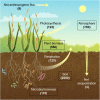Crops for Carbon Farming
- PMID: 34149744
- PMCID: PMC8211891
- DOI: 10.3389/fpls.2021.636709
Crops for Carbon Farming
Abstract
Agricultural cropping systems and pasture comprise one third of the world's arable land and have the potential to draw down a considerable amount of atmospheric CO2 for storage as soil organic carbon (SOC) and improving the soil carbon budget. An improved soil carbon budget serves the dual purpose of promoting soil health, which supports crop productivity, and constituting a pool from which carbon can be converted to recalcitrant forms for long-term storage as a mitigation measure for global warming. In this perspective, we propose the design of crop ideotypes with the dual functionality of being highly productive for the purposes of food, feed, and fuel, while at the same time being able to facilitate higher contribution to soil carbon and improve the below ground ecology. We advocate a holistic approach of the integrated plant-microbe-soil system and suggest that significant improvements in soil carbon storage can be achieved by a three-pronged approach: (1) design plants with an increased root strength to further allocation of carbon belowground; (2) balance the increase in belowground carbon allocation with increased source strength for enhanced photosynthesis and biomass accumulation; and (3) design soil microbial consortia for increased rhizosphere sink strength and plant growth-promoting (PGP) properties.
Keywords: PGPB (plant growth-promoting bacteria); carbon budget; carbon farming; plant-microbe interactions; rhizosphere; rhizosphere microbiome; sustainable agriculture.
Copyright © 2021 Jansson, Faiola, Wingler, Zhu, Kravchenko, de Graaff, Ogden, Handakumbura, Werner and Beckles.
Conflict of interest statement
The authors declare that the research was conducted in the absence of any commercial or financial relationships that could be construed as a potential conflict of interest.
Figures




References
-
- Abdullahi A. C., Siwar C., Shaharudin M. I., Anizan I. (2018). Carbon Capture, Utilization and Sequestration, ed. Agarwal R. K. (London: IntechOpen; ).
-
- Adkins J., Jastrow J. D., Morris G. P., Six J., de Graaff M. A. (2016). Effects of switchgrass cultivars and intraspecific differences in root structure on soil carbon inputs and accumulation. Geoderma 262 147–154. 10.1016/j.geoderma.2015.08.019 - DOI
-
- Ahkami A., White I., Handakumbura R. A., Jansson C. (2017). Rhizosphere engineering: enhancing sustainable plant ecosystem productivity in a challenging climate. Rhizosphere 3 233–343. 10.1016/j.rhisph.2017.04.012 - DOI
LinkOut - more resources
Full Text Sources
Miscellaneous

